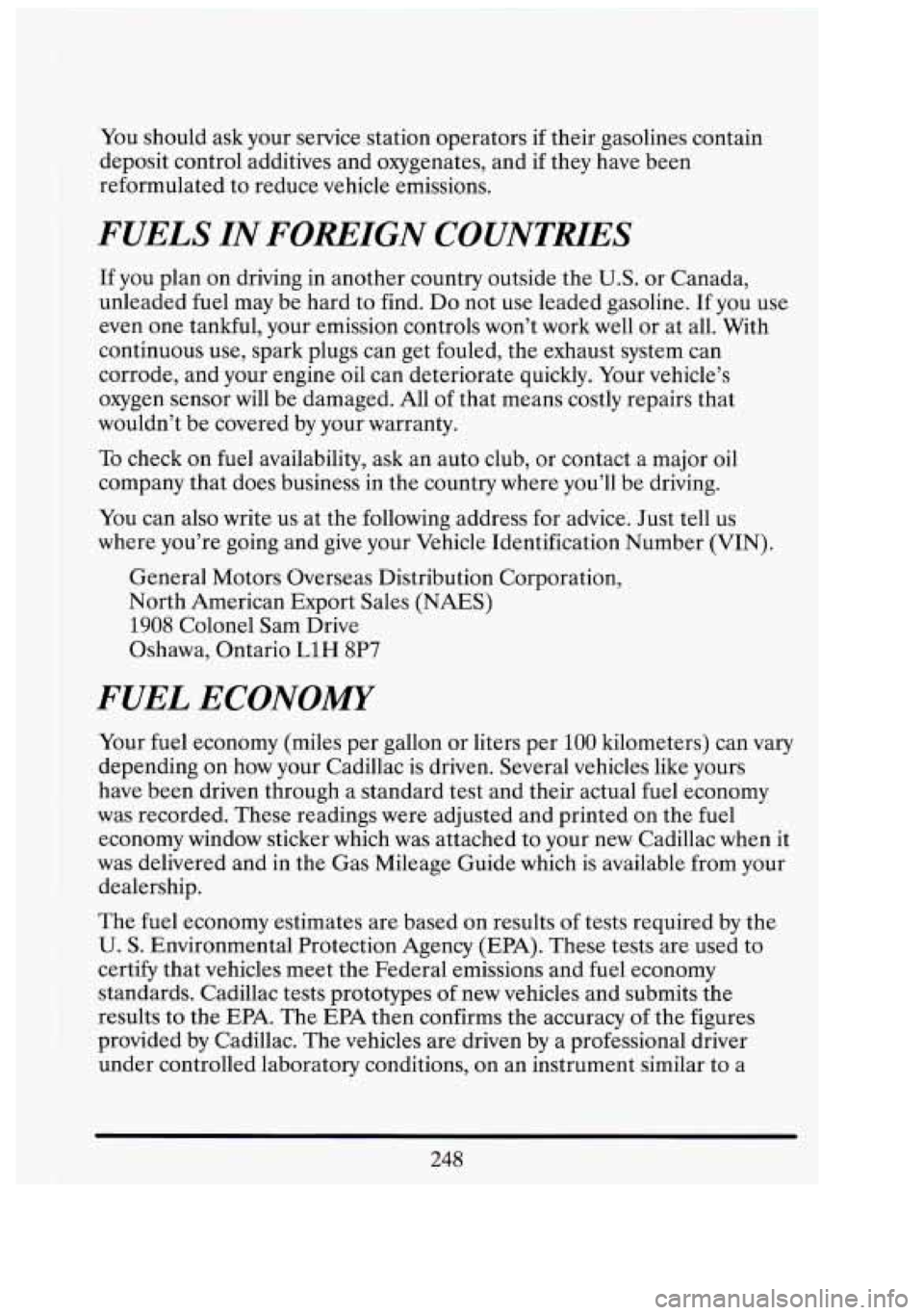gas mileage CADILLAC FLEETWOOD 1994 Owners Manual
[x] Cancel search | Manufacturer: CADILLAC, Model Year: 1994, Model line: FLEETWOOD, Model: CADILLAC FLEETWOOD 1994Pages: 398, PDF Size: 19.19 MB
Page 261 of 398

I
I
You should ask your service station operators if their gasolines contain
deposit control additives and oxygenates, and if they have been
reformulated to reduce vehicle emissions.
FUELS IN FOREIGN COUNTHES
If you plan on driving in another country outside the U.S. or Canada,
unleaded fuel may be hard to find. Do not use leaded gasoline. If you use
even one tankful, your emission controls won’t work well or at all. With
continuous use, spark plugs can get fouled, the exhaust system can
corrode, and your engine oil can deteriorate quickly. Your vehicle’s
oxygen sensor will be damaged. All
of that means costly repairs that
wouldn’t be covered by your warranty.
To check on fuel availability, ask an auto club, or contact a major oil
company that does business
in the country where you’ll be driving.
You can also write us at the following address for advice. Just tell us
where you’re going and give your Vehicle Identification Number (VIN).
General Motors Overseas Distribution Corporation,
North American Export Sales (NAES)
1908 Colonel Sam Drive
Oshawa, Ontario
LlH 8P7
FUEL ECONOMY
Your fuel economy (miles per gallon or liters per 100 kilometers) can vary
depending on how your Cadillac
is driven. Several vehicles like yours
have been driven through a standard test and their actual fuel economy
was recorded. These readings were adjusted and printed on the fuel
economy window sticker which was attached to your new Cadillac when
it
was delivered and in the Gas Mileage Guide which is available from your
dealership.
The fuel economy estimates are based on results of tests required by the
U. S. Environmental Protection Agency (EPA). These tests are used to
certify that vehicles meet the Federal emissions and fuel economy
standards. Cadillac tests prototypes of new vehicles and submits the
results to the EPA. The EPA then confirms the accuracy of the figures
provided by Cadillac. The vehicles are driven
by a professional driver
under controlled laboratory conditions, on an instrument similar to a
ni
I
I
o(
L
nl
248
Page 262 of 398

r
r
treadmill. These procedures ensure that each vehicle is tested under
identical conditions.
There are
two different fuel economy estimates for each vehicle, one Ior
city driving and one for highway driving.
To develop these two estimates,
separate tests are used to represent typical everyday city and rural
driving.
The test used to determine the city fuel economy estimate simulates a
7.5 mile (12 km), stop and go trip with an average speed of 20 mph
(32
km/h). The trip takes 23 minutes and has 18 stops. About one fifth
of the time is spent idling, as in waiting at traffic lights or in rush hour
traffic. Two kinds of engine starts are used: a cold start, which is similar to
starting a car in the morning after it has been parked all night and a hot
start, which is similar to restarting a vehicle after it has been warmed up,
driven and stopped for a short time.
The test used to determine the highway fuel economy estimate
represents a mixture of “non-city” driving. Segments corresponding to
different kinds
of rural roads and interstate highways are included. The
test simulates a 10 mile (17 km) trip with an average speed of 48 mph
(77 km/h). The test is run from a hot start and has little idling time and
no stops.
To assure that the fuel economy numbers are most useful for consumers,
the
EPA adjusts these laboratory test results to account for the difference
between controlled laboratory conditions and actual driving on the road.
The laboratory fuel economy results are adjusted downward
to arrive at
the estimates on the fuel economy window sticker and the Gas Mileage
Y Guide. The city estimate is lowered by 10 percent and the highwq
estimate
is lowered by 22 percent from the laboratory test results.
Experience has proven that these adjustments make the mileage
estimates correspond more closely to the actual fuel economy rea
by the average driver. lized
249